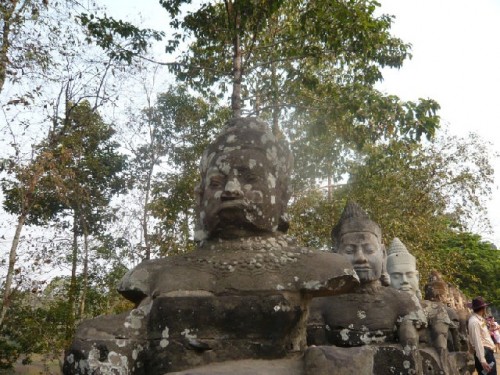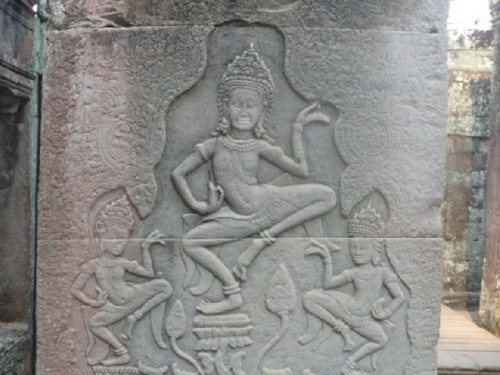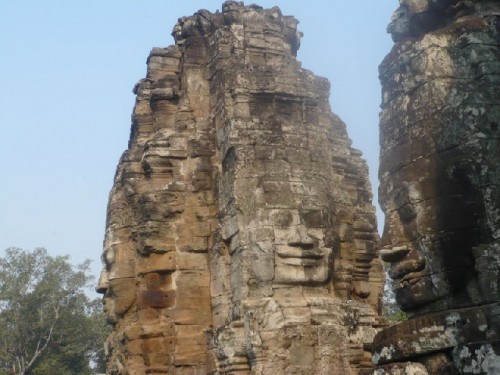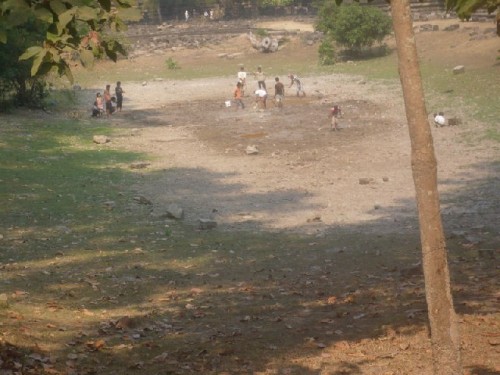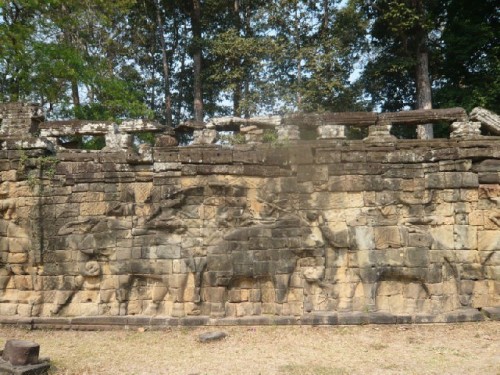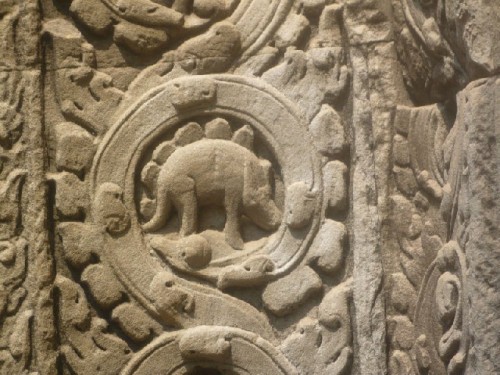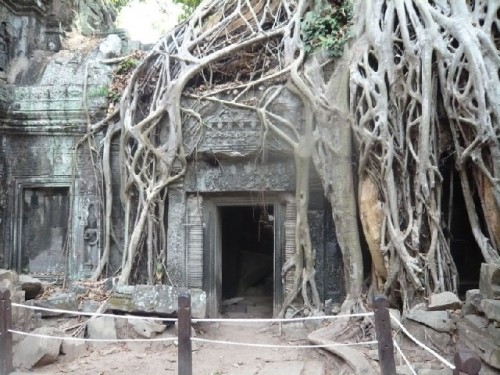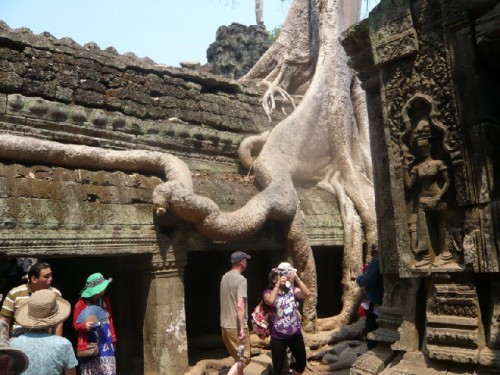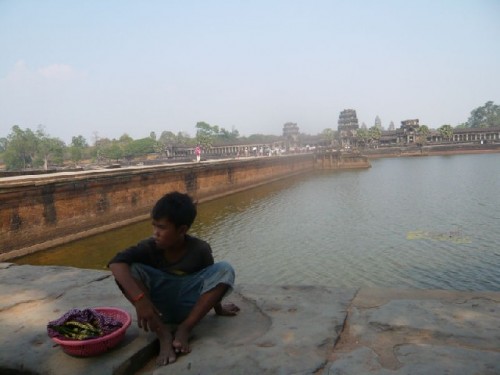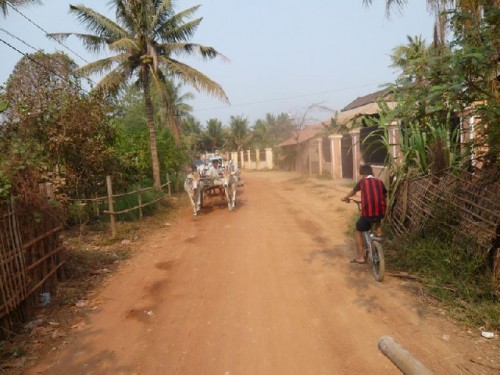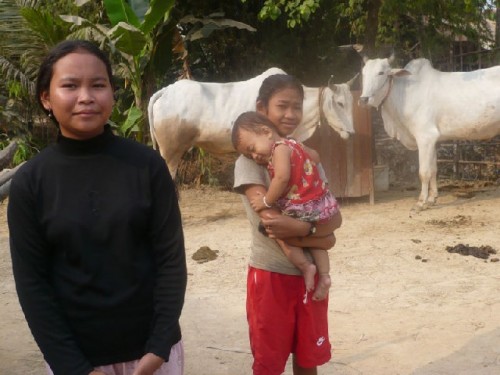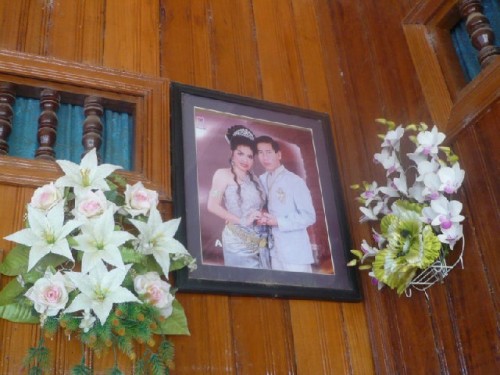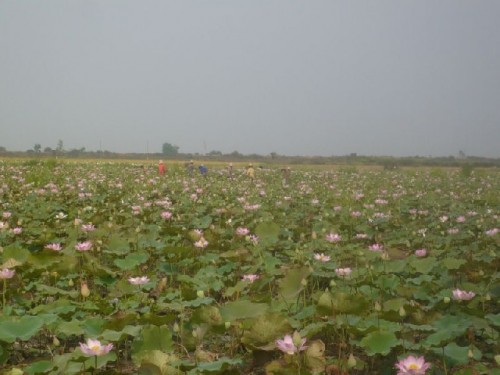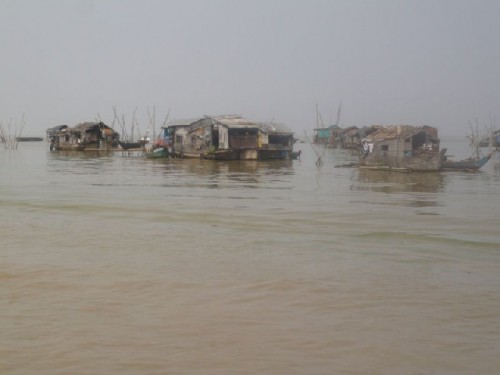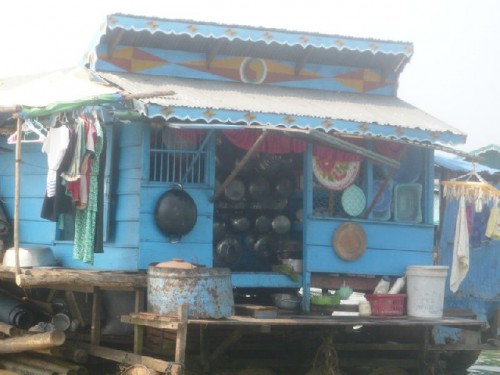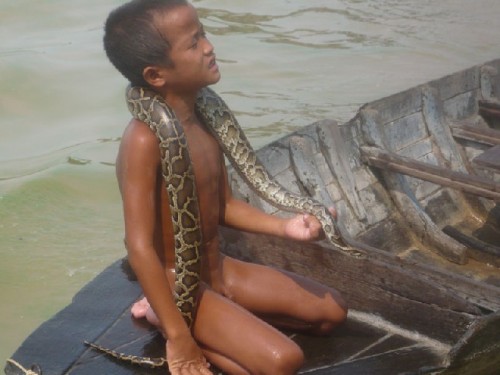Cambodia Part Three
Angkor and Tonle Sap
By: Zeren Earls - Sep 26, 2010
The next morning we departed from the hotel at 7:30 to beat the heat and the crowds for Angkor, the capital of the Khmer civilization, which ruled from the 9th to the 15th centuries. The current King of Cambodia, Norodom Sihamoni, and former King Norodom Sihanouk, who returned from exile in Beijing in 1993, come from a long line of monarchs going back to the ‘God Kings’ of Angkor. Discovered in 1859 by the French, Angkor became an overgrown jungle until 1992, when UNESCO declared it a World Heritage Site. Fortunately the ravaging Khmer Rouge, whose class war devastated Cambodia for three decades in the late 20th century, did not bomb antiquities; they only cut off stone Buddha heads to discourage religion.
Our tour of the vast urban complex, sprawling across an area of roughly 96 square miles, started at Angkor Thom (the Great City), surrounded by a defensive wall and outer moats, which were a link in the system of canals and reservoirs, designed to control the seasonal deluge and capture water for later use. We entered through the South Gate, one of five approached by causeways across the moat. Walking down the causeway, we were flanked by 108 large stone figures, on the right 54 gods and on the left 54 demons, all pulling a great snake supported on their knees. We continued on to Bayon, a celebrated temple with a four-faced statue of Buddha symbolizing equanimity, compassion, sympathy, love, and kindness, and built atop a Hindu shrine.
Other structures we visited were the Hindu temple mountain Baphoun, the Elephants’ Terrace, and the Terrace of the Leper King. The former terrace, where bas-reliefs depict almost life-size elephants, was used by the king to review his forces and to watch entertainers; the latter, with carvings portraying court attendants and rulers, was a royal crematorium. Stones were brought from the quarry by boat and carried to the site on elephant back. They were then stacked without mortar and carved.
The five-hour morning tour ended at the temple of Ta Prohm, ancestor of Brahma, which has been left the way it was found, covered by a dense jungle of trees and roots; following this we returned to the hotel. On the way, we saw locals draining water out of ponds by the bucket to catch fish, which could not swim away without water. After lunch and a brief rest, we headed to Angkor Wat, the world’s largest religious monument and the masterpiece of the temple complex. This Hindu temple is dedicated to Shiva.
We walked on a cobblestone causeway toward the five conical towers, representing Mount Meru, center of all physical and spiritual universes, and home to many gods in Hindu and Buddhist mythologies; the towers are surrounded by a moat 570 feet wide. Saffron-robed monks dotted the stone landscape. Wearing long pants, our shoulders covered and hats off, we climbed the steep stairs of the newly opened central sacred shrine. At the top, celestial Apsara reliefs on columns surrounded a sunken open area.
After our descent, we entered the central sanctuary and then circumambulated the gallery of bas reliefs along the perimeter of the massive edifice, as we viewed the Hindu epic Mahabharata in elaborate stone carvings. A bas-relief most remarkable in terms of execution was Churning of the Ocean of Milk, a Hindu creation myth. A huge panel depicted 88 devils on the left and 92 gods on the right churning a sea of milk with a giant serpent in order to extract the elixir of immortality, encouraged by singers and dancers — individual in dress, hairstyle, and ornamentation — overhead.
Just as astonishing were the spectacular roots of strangling fig and giant fichus that pushed their way through the sand and lava stonewalls around us. While these roots crack vaulted passageways, they also bind lintels and cannot be removed. Photographing this amazing symbiotic relationship of trees with surrounding stones, without hundreds of visitors posing in front of them, was a challenge.
Walking back on the causeway to catch the sunset, we settled on a wall near the moat. Snacking on crispy frogs’ legs, beef jerky, and salted peanuts accompanied by home-made rice wine, we watched the Angkor towers become silhouettes as the sun went down. As we departed, vendors lined the roadside, selling snacks of sticky rice packed inside hollow bamboo and sold by the stick. Mostly used for sweets, sticky rice is farmed separately from regular rice, which is the basic staple. Cambodians do not eat much bread except for an occasional baguette, which the French introduced during their colonial rule in Indochina (Cambodia, Laos, and Viet Nam). Vendors sell baguettes in deep baskets or on carts along traffic-heavy roads.
On our last day we traveled by oxcart to a local village south of Siem Reap to observe a day in the life of a rural community. Our group of fourteen split up and mounted seven carts, as each held two passengers. We entered the village on a dirt road lined with huts, some looking very modest and others more upscale. Here most people made their living as rice farmers. After our farmer host unhitched the two oxen on our cart from their yoke, he handed them over to his brother for feeding. Then he introduced us to his family. We walked around the spirit house to go upstairs and entered a large room built on concrete pillars. The room served as the living room and bedroom. There were wedding pictures of family members on the wall, and mats serving as bedding neatly stacked in a corner. The ground floor was used for rice storage. The family also raised crocodiles for their skin.
Our excursion south continued by boat to Tonle Sap, which means “Great Freshwater Lake” and is the largest one in Southeast Asia. It expands to four times its size during the rains in June and July at its Mekong basin. Flooding begins when the lake’s main outlet, the Tonle Sap River, reverses its course to flow north into the lake, causing its dwellers to move their homes up to fifteen times a year. The lake and its floodplain are vital to the country’s rice farming and fishing. As a seasonal wetland for migrating birds and other wildlife, it is recognized as a UNESCO biosphere reserve.
We visited a fishing village, one of 170 around the lakefront, where daily life glides by on the water. In this village of 3000, people lived in floating thatched-roofed houses on hollow bamboo poles, some with their own gardens and guard dogs, and all with TV antennas. Our boat followed a fairly wide main thoroughfare, with narrow passages between houseboats and extensive fish traps. The lake is a sanctuary for birds and home to 107 kinds of fish; yet it is not deep. The boats’ propellers churn up its rich silt, spewing pieces of brown sediment into the air. On our boat route we passed women selling fruits and vegetables from a sampan, fishermen selling their catch, and naked boys enticing tourists, with snakes wrapped around their necks. Other points of interest were a floating market, a Catholic Church, a community center, and a school where children arrived by rowboats, the older ones transporting the younger ones. During recess they bought snacks from vendors who arrived by boat. Children in neat uniforms rowing themselves from their houseboats to school were memorable images.
At the end of this visit we transferred to the Siem Reap airport for our flight to Bangkok.
During our time in Cambodia we gleaned a good idea of the country and its people. Having worn down the Khmer Rouge and broken their power, the nation is calm under a constitutional monarchy. Its economy, which was virtually destroyed, has moved away from communist ideology toward a market economy. Presently the greatest sources of revenue are wood exports, foreign aid, and tourism. One million Cambodians work illegally in Bangkok, only 155 kilometers from the Cambodian border. The country needs to invest heavily in education and in building infrastructure; people still use oil lamps and battery-driven TVs.
Cambodia is rapidly catching up to today’s technology and global telecommunications, while trying to revive its traditional art and culture, destroyed by class warfare. It has made big strides in recovering its pre-war tourist industry. New hotels are up, such as the Tara Angkor, where we stayed; roads are under construction; people are friendly and eager to please visitors. Angkor Wat is a major attraction, drawing 5000 visitors a day. Added to these is the beauty of the landscape, with tropical fruits and flowers everywhere. I very much enjoyed our journey of discovery to this bucolic part of Southeast Asia.



